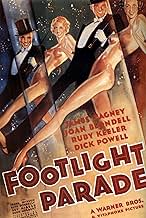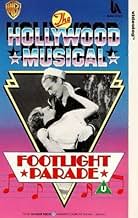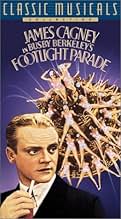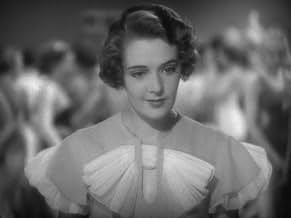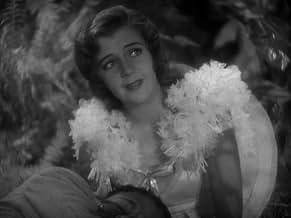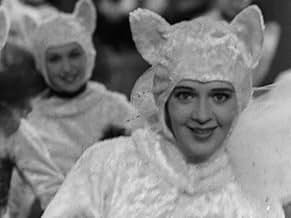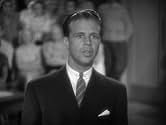Ajouter une intrigue dans votre langueChester Kent struggles against time, romance, and a rival's spy to produce spectacular live "prologues" for movie houses.Chester Kent struggles against time, romance, and a rival's spy to produce spectacular live "prologues" for movie houses.Chester Kent struggles against time, romance, and a rival's spy to produce spectacular live "prologues" for movie houses.
- Réalisation
- Scénario
- Casting principal
- Récompenses
- 3 victoires au total
- Chorus Girl
- (non crédité)
- Chorus Girl
- (non crédité)
Avis à la une
Sure, Warner Bros. tries to cover the orgy with the fig leaf of two cheerful innocents played by a sappy Dick Powell and a virginal Ruby Keeler. But it doesn't work, because everyone else gets in on the fun, including that human buzz-saw Jimmy Cagney and everyone's favorite sassy dame Joan Blondell. Director Lloyd Bacon proves too he knows what to do, giving us an eyeful of Blondell endlessly rolling and unrolling her hosiery, while the writers pepper the conversation with suggestive one-liners. Yeah, it's a great movie-- good enough to help bring down the heavy hand of censorship the following year, and put an end to damp dreams like "Beside a Waterfall". But not even the Watchdogs of Public Morality could stop Berkeley's deliriously suggestive pageantry that would live on at even that most repressed of studios, MGM. Sure, Astaire-Rogers may have been more graceful and a whole lot more chaste, no doubt producing more sheer polish-- still and all, don't let this unabashedly pagan celebration pass you by. As they say around the owl cage, it's a real hoot.
Watching it again tonight, I was, however, struck yet once again by the genius of Busby Berkeley in staging the last three numbers, the "prologues." Most remarkable of a very remarkable trio for me is "Beside a waterfall." It just keeps building and building and building. Yes, of course, some of the shots of the women in the water are very erotic. It was 1933, after all, and before the Hayes Code. Berkeley and Warner Brothers understood that pretty women posed erotically had a real appeal to men,
------------------------------------
I watched the end of this movie again this morning. Perhaps I paid closer attention to this number this time, perhaps I was just in the right "mood." Either way, I marveled at the suggestiveness of so much of it. Those jets of water spurting up - I use the verb advisedly - between the swimming women's legs. All those shots of women opening and closing their legs. It was remarkably erotic on my 46" tv screen. What must it have been like in 1933 on huge movie theater screens in the era before multiplexes????
==========================================
But these erotic poses are not JUST erotic poses. The number keeps building and building and building. What will he do next, you keep wondering? Oh, that. But "that" is even more incredible than what has come before. By the time you get to the end of this number, you're exhausted, not just physically and erotically, but imaginatively as well. How could anyone have maintained and built on that suspense for 10 whole minutes? I can't tell you, but Berkeley did.
Third of the three prologues, "Shanghai Lil," is definitely not something that could have been filmed the same way just a year or two later when the Production Code was put in force. We see an opium den, a lot of prostitutes, at least one interracial couple, etc.
Having watched it again tonight, I will add that this is a strange "musical." There is almost no music for the first hour and a half. It's all in the three closing numbers. But what numbers!
First-rate Busby Berkeley musical from Warner Bros. with a terrific cast and the wonderful choreography Berkeley was known for. Most of the musical numbers are saved for the last half-hour but they're all great. James Cagney and Joan Blondell are lots of fun. They always had perfect chemistry. There's also a lot of snappy pre-Code lines, particularly from Blondell. Dick Powell and Ruby Keeler are also enjoyable. Nice support from solid character actors Frank McHugh, Guy Kibbee, Arthur Hohl, and Hugh Herbert. Fast-paced and highly entertaining. Essential for fans of Berkeley or the great leads.
The first half of "Footlight Parade" is preparation for a musical extravaganza which occupies the last half of the film. Chester Kent (Cagney) is about to lose his job and does lose his playgirl wife as a result of talking pictures squeezing out live stage musicals. His producers take him to see a popular talky of the day, John Wayne in "The Big Trail." Before each showing of the flick, a dance number is presented as a prologue. Shorts, news reels, serials, and cartoons would later serve the purpose. Kent gets the idea that a prologue chain would be the road to salvation for the dwindling live musical business. Kent is basically an idea man along the lines of choreographer Busby Berkeley. Could it be that Cagney's character is patterned after Berkeley? Could be.
In preparation for the prologues, Kent learns that his ideas are being stolen by a rival. He uncovers the traitor, fires him, then unbeknown to him a new leak is planted in the form a dazzling temptress. His assistant, Nan Prescott (Joan Blondell - soon to be Mrs. Dick Powell) has the hots for Kent and is determined to expose the wiles of the temptress. A new singer from Arkansas College shows up in the form of Scotty Blain (Dick Powell) who turns out to be a real find and is paired with Bea Thorn (Ruby Keeler). The resulting three prologue musicals, which couldn't possibly have been presented on any cinema stage of the day, are as fresh and enjoyable today as they were over seventy years ago, "Honeymoon Hotel," "By a Waterfall," and "Shanghai Lil."
Of special note is the song and dance of tough-guy James Cagney. Like Fred Astaire and Bill "Bojangles" Robinson, Cagney's dancing appeared natural and unrehearsed, although hours went into practice to get each step just right. Not as good a singer as Astaire, Cagney's singing, like Astaire's, sounded natural, unlike the crooning so popular at the time. It's amazing that one person could be so talented and so versatile as James Cagney.
Most critics prefer the "Shanghai Lil" segment over the other two. Yet the kaleidoscopic choreography of "By a Waterfall" is astonishing. How Berkeley was able to film the underwater ballets and to create the human snake chain must have been difficult because it has never been repeated. The close up shots mixed brilliantly with distant angles is a must-see. The crisp black and white photography is much more artistic than it would have been if shot in color.
Though not nearly as socially conscious as "Gold Diggers of 1933," "Footlight Parade" stands on its own as one of the most amazing and outrageous musicals ever put on the big screen.
Le saviez-vous
- AnecdotesFirst film where James Cagney dances - showing off his vaudeville and stage experience as a song-and-dance man. Cagney lobbied Warner Bros. to play this role. He would show off these talents to their fullest in La Glorieuse Parade (1942).
- GaffesAfter the "By A Waterfall" prologue ends, the film cuts to the audience giving an animated and thunderous applause, but in the balcony there is no applause or reaction. In fact, there is no movement whatsoever. They are perfectly still which indicates that a photo or painting was used for the balcony audience and then merged with the live theatre audience. The same photo/painting was also used for the "Shanghai Lil" balcony audience.
- Citations
Nan Prescott: You scram, before I wrap a chair around your neck!
Vivian Rich: [Angrily] It's three o'clock in the morning - where do you want me to go?
[Nan starts to speak, but Vivian immediately cuts her off]
Vivian Rich: You cheap stenographer...
Nan Prescott: Outside, countess. As long as they've got sidewalks YOU'VE got a job.
[Shoves her out, gives her a swift kick in the rump, and slams the door behind her]
- Versions alternativesThere is an Italian edition of this film on DVD, distributed by DNA srl, "VIVA LE DONNE! (1933) + AMORE IN OTTO LEZIONI (1936)" (2 Films on a single DVD), re-edited with the contribution of film historian Riccardo Cusin. This version is also available for streaming on some platforms.
- ConnexionsEdited into Busby Berkeley and the Gold Diggers (1969)
- Bandes originalesA Vision of Salome
(1908) (uncredited)
Music by J. Bodewalt Lampe
Played during the prologue scene in the movie theater
Meilleurs choix
Détails
Box-office
- Budget
- 703 000 $US (estimé)
- Montant brut mondial
- 276 $US
- Durée
- 1h 44min(104 min)
- Couleur
- Rapport de forme
- 1.37 : 1



